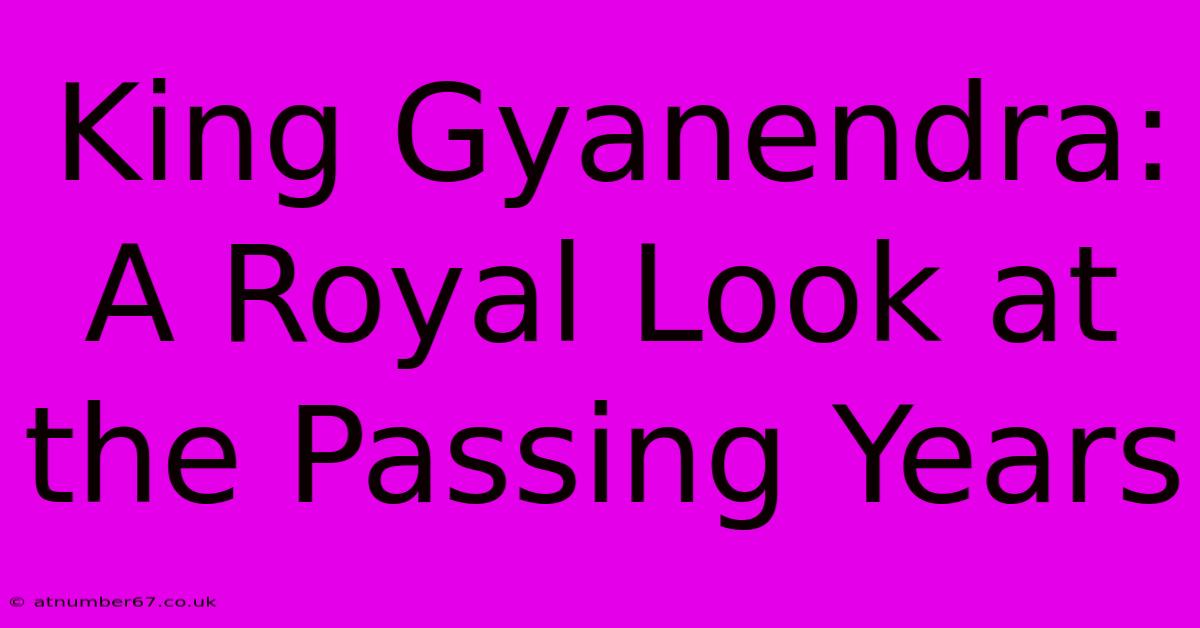King Gyanendra: A Royal Look At The Passing Years

Table of Contents
King Gyanendra: A Royal Look at the Passing Years
King Gyanendra Bir Bikram Shah Dev, the last reigning monarch of Nepal, remains a figure of significant historical and political interest. His reign, marked by both pomp and controversy, offers a fascinating case study in the complexities of monarchy in a rapidly changing world. This article explores the key phases of his life and reign, analyzing their impact on Nepal’s trajectory towards a republic.
From Prince to King: A Life Shaped by Destiny
Born on July 8, 1947, Gyanendra's path to the throne was far from straightforward. While initially a relatively peripheral figure in the royal family, overshadowed by his elder brother King Birendra, fate intervened tragically. The 2001 royal massacre, which claimed the lives of King Birendra, Queen Aishwarya, and several other members of the royal family, catapulted Gyanendra into the position of King. This unexpected ascension marked a turning point not only for his life but for the entire nation.
The Early Years and the Shadow of the Massacre
Gyanendra's early life was characterized by a more traditional upbringing compared to his siblings. His education and experiences shaped a worldview seemingly at odds with the progressive reforms emerging in Nepal at the time. While detailed accounts of his personal life during this period are scarce, it's clear that the 2001 massacre cast a long shadow, forever altering the course of his life and the future of the Nepalese monarchy. The weight of this tragedy and the sudden responsibility of leadership heavily influenced his subsequent actions.
The Reign and the Rise of Controversy: A Nation at a Crossroads
Gyanendra's reign was fraught with challenges. He inherited a nation grappling with a protracted Maoist insurgency, widespread poverty, and growing calls for democratic reforms. His initial attempts to address these issues met with mixed results. However, his later actions, particularly his seizure of executive power in 2005, proved deeply controversial and ultimately contributed to the monarchy's downfall.
The 2005 Royal Coup and its Aftermath
The 2005 royal coup, where King Gyanendra dismissed the elected government and assumed direct control, proved to be a pivotal moment. While he claimed it was necessary to restore order and quell the Maoist insurgency, it was widely condemned both domestically and internationally as a setback for democracy. This action alienated a significant portion of the Nepalese population and strengthened the resolve of pro-democracy movements. The widespread protests that followed exposed the growing public dissatisfaction with the monarchy's authority.
The Abdication and the Legacy of a King
The growing pressure from the people, the success of the peace process with the Maoists, and the eventual drafting of a new constitution led to the abolition of the monarchy in 2008. Gyanendra abdicated, marking the end of centuries-old royal rule in Nepal. His legacy remains complex and deeply debated. While some view him as a necessary figure during a time of crisis, others see him as a symbol of autocratic rule and a major impediment to Nepal's democratic progress.
Analyzing the Lasting Impact
Analyzing Gyanendra's reign requires careful consideration of the broader socio-political context. While his actions undoubtedly played a significant role in the monarchy's demise, the underlying issues of poverty, inequality, and the Maoist insurgency were far more deeply rooted. His legacy is therefore intricately intertwined with the broader history of Nepal’s transition from monarchy to republic.
Conclusion: A Royal Chapter Closed
King Gyanendra's story is a compelling reminder of how swiftly circumstances can change, even for those born into privilege and power. His life and reign represent a pivotal chapter in Nepalese history, serving as a cautionary tale about the challenges of maintaining relevance and legitimacy in a rapidly evolving political landscape. The passing years may offer a more balanced perspective on his role, but the controversies surrounding his reign will undoubtedly continue to be debated for generations to come. His story is a compelling mix of tradition, tragedy, and the ultimate triumph of democratic aspirations in Nepal.

Thank you for visiting our website wich cover about King Gyanendra: A Royal Look At The Passing Years. We hope the information provided has been useful to you. Feel free to contact us if you have any questions or need further assistance. See you next time and dont miss to bookmark.
Featured Posts
-
Lamine Yamal The Youngest Sensation In Football
Mar 31, 2025
-
Fuerza Y Honor Son Su Vestidura A Path To Fulfillment
Mar 31, 2025
-
Raila Odinga Age And The Power Of Experience
Mar 31, 2025
-
Kapali Carsi Suicide A Wake Up Call
Mar 31, 2025
-
You Wont Believe Ivana Alawis Real Age
Mar 31, 2025
